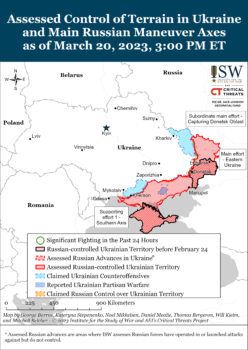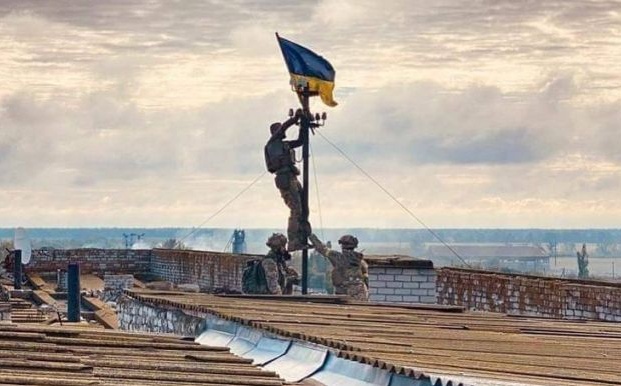Ukrainian troops raise the national flag above a hospital in Vysokopillia after liberation of the town in southern Ukraine from Russian occupiers, September 4, 2022
Thursday’s Coverage: Zelenskiy Visits Bakhmut Frontline as Russian Offensive Slows

Map: Institute for the Study of War
UPDATE 1811 GMT:
The UN says it has documented dozens of summary executions of prisoners of war by both Russian and Ukrainian forces during Moscow’s invasion.
The Office of the High Commissioner for Human Rights documented the summary execution of 15 Ukrainian POWs by Russian forces. Ukrainian POWs were also used as human shields and tortured. Two wounded POWs died from lack of medical care.
The investigators cited lack of cooperation from Russian and Russian proxy authorities, including denial of access to any POWs held in Russia, despite repeated requests. Once once, in August 2022, was a UN team allowed to meet — but not interview — 13 Ukrainian POWs held in Russian-occupied Luhansk in eastern Ukraine.
Through open-source information, in situ visits, and witness interviews, the OHCHR team documented the summary execution of at least 25 Russian POWs being held by Ukrainian forces.
In contrast to the lack of cooperation from Russian authorities, UN personnnel were “full and confidential access” to Russian POWs held in official places of internment by Ukraine.
UPDATE 1803 GMT:
Ukraine Deputy Prime Minister Oleksander Kubrakov says that, until the security situation improves, the port city of Mykolaiv cannot be added to the July 2022 deal lifting the Russian blockade of Ukrainian grain exports.
The deal was extended covering three Black Sea ports — Odesa, Chornomorsk, and Pivdennyi — was extended last week, although it is unclear if the extension is for 60 or 120 days.
Kubrakov reiterated on Friday that the agreement is up to July, while Russia insists it is only through May.
He said that of the inclusion of Mykolaiv, “A lot will depend on our success on the battlefield, as it was at the beginning of the grain initiative.”
Mykolaiv’s ports accounted for about 35% of Ukrainian food exports before the Russian invasion 13 months ago.
UPDATE 1507 GMT:
Dmitry Medvedev, former Russian President and current Deputy Secretary of the State Security Council, appears to have acknowledged the shift from Moscow’s offensive to a Ukrainian counter-offensive (see Original Entry).
“They [Ukraine] are preparing for an offensive, everyone knows that. Our general staff is calculating this and is preparing its own solutions,” Medvedev said in an interview with Russian media.
UPDATE 0924 GMT:
The death toll has risen to five in the Russian missile strikes on Kostyantynivka in the Donetsk region (see below).
The bodies of two men have been recovered from the strike on an “invicibility point”.
UPDATE 0800 GMT:
Three women have been killed and two other people injured in a Russian missile attack on Kostantynivka in the Donetsk region in eastern Ukraine.
The Russians fired two S-300 missiles at 1 a.m. on the city, which is 20 km (12.5 miles) west of the frontline in Bakhmut.
One hit an “invincibility point”, where civilians can use the internet, charge devices and fulfil basic needs.
The three victims, aged 57 to 62, had been displaced from other areas in Donetsk.
Two civilians were killed and nine injured in Russian shelling of the Sumy region in northern Ukraine.
There was extensive damage in four communities: Bilopillia, Vorozhbinska, Richkivska, and Mykolaivka.
Bilopillia alone suffered 80 strikes by rockets, 20 from artillery, as well as an airstrike.
Presidential Chief of Staff Andriy Yermak posted footage of the aftermath of the attack.
Білопілля. Сумщина. Після нічного обстрілу російськими авіабомбами триває розбір завалів. pic.twitter.com/muBPOkOFa3
— Andriy Yermak (@AndriyYermak) March 24, 2023
ORIGINAL ENTRY: As Russia’s last-gasp offensive in eastern Ukraine stalls, talk is building of a Ukrainian counter-offensive taking advantage of Moscow’s heavy losses of troops, armor, and equipment.
Ukrainian, US, and UK analysts are all assessing that Russia’s 10-month assault on Bakhmut in the Donetsk region is slowing. Having taken the eastern part of the city, which had a pre-war population of about 70,000, Wagner Group mercenaries have been halted at the Bakhmutka River for weeks.
The analysts note that the mercenary attacks are now on villages to the north and south of Bakhmut, still hoping to cut off the city, while Russian forces are focusing on the town of Avdiivka, about 90 km (56 miles) to the south.
A Ukrainian soldier on the frontline north of Bakhmut told journalists:
It was really hot here a week ago, but in the last three days it has been more quiet.
We can see this in the enemy’s air strikes. If before there were five-six air raids in a day, today we had only one helicopter attack.
Serhii Cherevatyi, a spokesman for the Eastern Command of Ukraine’s armed forces, said, “We knock them out. In fact, there will be no more Wagner fighters in a little while if they continue the same dynamics.”
“Very Soon We Will Take Advantage”
Ukraine’s commander of ground forces Oleksandr Syrskyi cautioned on Thursday, “The aggressor does not give up hope of taking Bakhmut at any cost, despite the losses in manpower and equipment.”
But he said the Wagner mercenaries “are losing considerable strength and are running out of steam”, opening the way to Kyiv’s counter-offensive.
He referred to successes last summer and autumn after Russian forces weakened themselves with costly assaults: “Very soon, we will take advantage of this opportunity, as we did in the past near Kyiv, Kharkiv, Balakliya and Kupyansk.”
Wagner Group head Yevgeny Prigozhin, embroiled in in-fighting with the Russian Defense Ministry, supported the Ukrainian commander’s summary.
In a 23-minute interview on Thursday, Prigozhin claimed Ukraine has 200,000 reserves gathering to attack along the entire eastern frontline, including 80,000 in and near Bakhmut.
However, the Ukrainian effort may be more likely in the south. A counter-offensive would not only seek to liberate occupied areas in the Kherson and Zaporizhzhia regions, but also to cut off Russian ground access to Crimea, seized by Moscow in 2014.
There was a flutter on Thursday when the Ukraine General Staff said Russian forces had withdrawn from the key town of Nova Kakhova on the east bank of the Dnipro River in the Kherson region. The area has one of Ukraine’s largest dams and hydroelectric plants.
However, the Staff later withdrew the report, saying it had been issued “as a result of incorrect use of available data”.
While pledging the eventual liberation of all of the country, Ukraine President Volodymyr Zelenskiy told a summit of European Union leaders that the campaign would be prolonged by delays in the delivery of long-range missiles, by a lack of modern warplanes, and by weaknesses in international sanctions on Moscow.
Zelenskiy added in his nightly address to the nation:
I noted things that, unfortunately, do not allow us to speed up the liberation of the territories, do not allow us to speed up the end of the war.
First of all, it is the supply of more effective weapons to our warriors – long-range weapons and modern aircraft, regarding which we still see a certain delay in the decisions of our partners. It is also important to move more actively in the direction of new and stronger sanctions against Russia for terror and new steps in our Ukrainian integration with the structures of the European Union.
I am sure the partners have heard Ukraine’s position.

